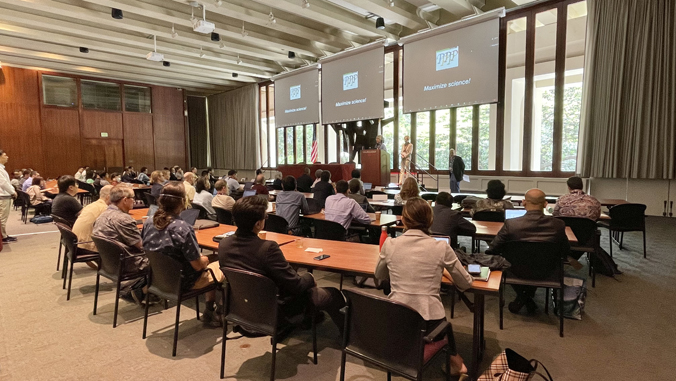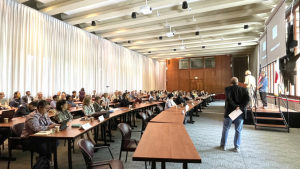
More than 100 experts in the field of high energy physics gathered at the East-West Center for the 45th meeting of the U.S.-Japan Science and Technology Cooperation Program in High Energy Physics, hosted by the University of Hawaiʻi at Mānoa and the Lawrence Berkeley National Laboratory, May 22–23.
High energy physics explores what the world is made of and how it works at the smallest and largest scales from the tiniest particles to large objects in outer space.

“It’s important for us at UH for two reasons, one is to make the broader community aware of our high energy physics research at the University of Hawaiʻi, but also to network and stimulate connections with funding agencies and researchers in the U.S. and Japan,” said conference organizer and Professor Thomas E. Browder from the UH Mānoa Department of Physics and Astronomy in the College of Natural Sciences.
Two of the event’s speakers were Regina Rameika, U.S. Department of Energy Office of High Energy Physics associate director, and Brian Beckford from the Intensity Frontier program of the U.S. Department of Energy’s Office of High Energy Physics.
“It’s absolutely critical,” said Rameika. “I’m familiar with U.S.-Japan cooperation and now getting to be here to talk about the actual proposals and the work that we’re doing together really helps to emphasize that.”
Beckford leads the Intensity Frontier program, which UH Mānoa is part of. The program involves hands-on experiments using high-intensity beams looking for rare processes.
The symposium opened with an introduction from UH President David Lassner. Plenary talks followed, which included highlights on cutting-edge research projects in the U.S. and Japan, including the Deep Underground Neutrino Experiment by UH Mānoa Professor Jelena Maricic.
Funding opportunities for cutting-edge research
Natalie Roe, Associate Laboratory Director for Physical Sciences at the Lawrence Berkeley National Laboratory, a U.S. Department of Energy Office of Science national laboratory managed by the University of California, chaired the first day’s opening session. Roe pointed out one of the goals of the symposium is to kickstart and continue funding opportunities for innovative research projects.
“Both the Department of Energy and the MEXT (Ministry of Education, Culture, Sports, Science and Technology) funding agency in Japan put in money to support collaborative proposals where we have both the U.S. and Japanese principal investigators working together, often on cutting-edge research and development in accelerator physics and detector physics,” Roe said. “And this is a way of getting our younger scientists working together, which establishes the foundation for the next generation of collaboration.”
Professor Masanori Yamauchi, director general of the High Energy Accelerator Research Organization in Japan, presented on his organization’s latest project developments, including J-PARC, a multi-purpose high-intensity proton accelerator complex, and SuperKEKB, a high-luminosity electron-positron collider.
“Since this endeavor is beneficial to all human beings, we have to have collaboration of scientists from as many countries as possible to do research,” Yamauchi said. “The U.S. and Japan are a symbol of this collaboration.”
The symposium was started in 1979 under an agreement between the Japan and U.S. governments on cooperation in research and development in science and technology. In 2019, the 40th anniversary was celebrated with a symposium held in Hawaiʻi. It has become a tradition for both countries to alternate hosting the symposium in Hawaiʻi and Japan.
—By Marc Arakaki

